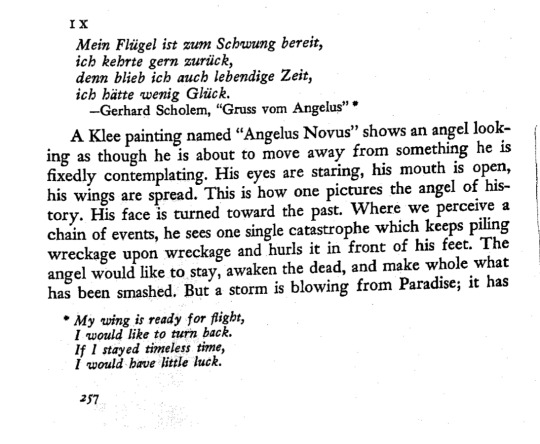#angelus novus
Text

{2023} angelus novus (after w.b.)
https://www.marxists.org/reference/archive/benjamin/1940/history.htm
for Scherenschnitt 3.0, a collection of gifs reinterpreting the traditional art of papercuts
#gif#animation#anna malina#black and white#artists on tumblr#original art#paper collage#collage animation#papercuts#laser prints#words#angels#2023#scherenschnitt 3.0#walter benjamin#angelus novus#paul klee
499 notes
·
View notes
Text

The Angel of History (After Klee and Benjamin) // (Deluxe Paint IV, 2023) // for Tezos@South Beach, Dec. 6-9, Miami Art Basel 2023 (cw: flashing)
#angel#gif#pixel art#pixels#art#illustration#digital painting#webcore#amiga#deluxe paint#dpaint#klee#walter benjamin#angelus novus#glitchcore#flashing
106 notes
·
View notes
Text


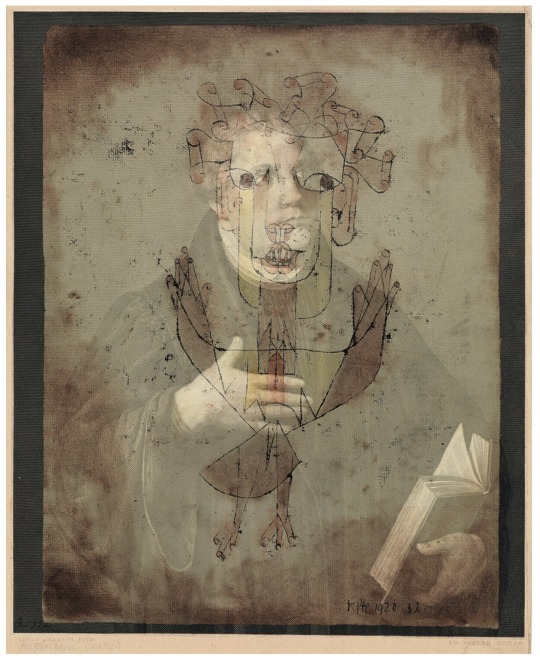
I'm trying to clear my months-old tabs about R.H. Quaytman's 2015 shows of work relating to her research and discovery of a 19th century print of Martin Luther sandwiched underneath Paul Klee's 1920 monoprint, Angelus Novus.
Angelus Novus is most famous because of its connection to Walter Benjamin, who compared it to the Angel of History in the last essay he wrote before he died.
Since 2015, Klee scholar Annie Bourneuf has put together a renewed history of Angelus Novus that looks at its creation, references, and context in light of Quaytman's discovery.
images: Klee, Angelus Novus, 1920 from the Israel Museum
Friedrich von Müller's 1838 etching after a 1520 portrait of Martin Luther by Lucas Cranach
R.H. Quaytman's 2015 composite image of the two confirming Klee affixed his monoprint on top of this old etching.
#r.h. quaytman#paul klee#angelus novus#walter benjamin#angel of history#not the same#art history all the way down
20 notes
·
View notes
Text
The Power of Dune Part Two’s Final Act: Stepping Away From the Messiah
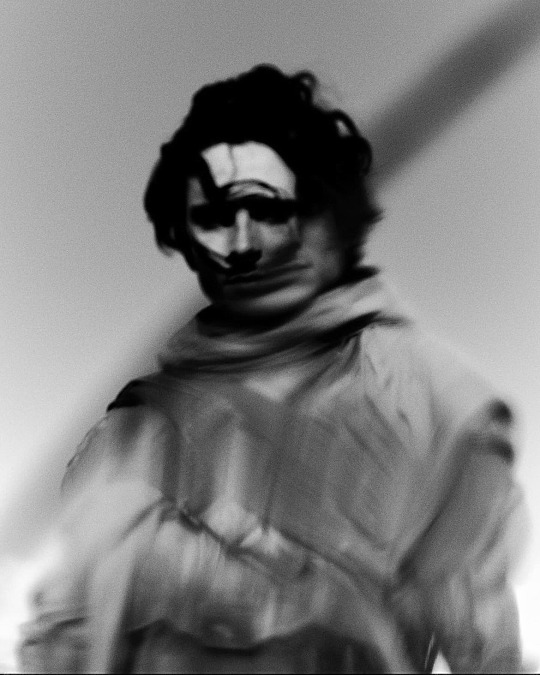
Stunning photo by Jack Davidson
So I didn't think I would be talking about Dune in my first post for this page (considering that I intended it to be more Star Wars focused and also since I haven't read the Dune books yet), but the final stretch of this movie has been on my mind ever since I left the theater a few weeks ago.
(Spoilers for Dune: Part Two)
It's strange in the sense that we are suddenly distanced from Paul, and also in that the climax seems to accelerate the story faster than ever before. So far (in both movies), there has been a pretty strong focus on Paul and a very deliberate pace that let all the plotlines simmer. It’s a masterclass of immersion, both technically and emotionally. The humanity of its characters aren’t lost in the many elements at play. Paul is a character whose empathy and how it makes him conflicted with what is placed before him make him quite likable. Spending so much time with him, Chani, and Stilgar makes us grow attached to them, not just because they’re the heroes, but because they feel real. And yet we’re pushed away. In the third act Paul's dark transformation happens swiftly (you’d initially think from how it’s shown the water of life turns you evil), and by the story’s end we only see Paul from a distance in the eyes of other characters, unable to see him resolving the concerns we’ve wrestled along with him, unable to get a good read on his motivations anymore. The final battles with our heroes happen rather quickly as victory over the Harkonnans and the Emperor comes pretty easily. On one hand this shift could feel unsatisfying, and the first time I watched the movie I was a little unsatisfied. But I’m not here to say this is a fault of the movie; in fact, this shift results in something greater happening, and it’s the most powerful triumph of Part Two’s story.

By the end, even when we do zoom in on Paul we're not sure what's really behind his intensity. (All the Dune screencaps are from Dune Perfect Shots 4K on Twitter).
Dune’s story up until this point, from what I know about these two films at least, is all about complexity, discerning the many variables, the need to carefully monitor both these variables and one's own behavior. The importance of mastering oneself. (This video by Alt Shift X talks about this really well, and it definitely helped me understand this aspect of the story better). But Paul’s tests, like the Gom Jabbar in Part 1 and the worm ride in Part 2, carry not just that significance but also the danger of a prophetic horror being more and more certain. Therein lies an irony - you can gain power but tied to it is something much larger that’s out of your control. This becomes pretty key to the whole story, and there’s something I was reminded of that helped me put all this into perspective. I brought this up in my first-time watch review too, but I think I have more to say about it now. But bare with me as this might end up being convoluted.

In one of my classes this semester we read the poem “The Promised Land” by Gabeba Baderoon, and I was really struck by this image that it alludes to called the Angel of History. Described by Walter Benjamin based on the painting Angelus Novus by Paul Klee, it depicts an angel whose wings get caught in the winds of a destructive storm “blowing from Paradise.” It’s trapped in the storm’s momentum going forwards with no way to escape. All the while, its head is permanently twisted backwards, forced to watch the wreckage of the storm, named progress, gathering below it. From what we discussed in that class this disturbing image suggests that all the events of history, all that we do or achieve or create, is not a series of events affecting each other, but instead one ever-building catastrophe barreling forwards. Both the Bene Gesserit’s century-spanning machinations and Jessica’s usurping of it all by birthing a boy. Whether the Harkonnen house or the Atreides house controls Arrakis. All of these are merely before a future that’s larger than any of them individually; the messiah and his holy war will come regardless. Even if it’s towards her own end rather than that of the Bene Gesserit, Jessica still uses their propaganda to facilitate his rise. The two houses end up converging anyways in their family trees with the Baron, and Muad’dib Atreides embraces it, merging the two families’ ideologies like the Kwizatz Haderach was always intended to. Whether his sudden ruthlessness is him embracing his desire for revenge or actually a strategic choice after sifting through the past and futures laid out, we’re denied of knowing for sure as we look at him from afar, and this denial by the film questions if the answer even matters much. The Angel image and the movie’s narrative dispel the idea that we have the capability to easily fix things when we make progress. It’s a notion that renders reasoning or means as having little ability to empower, envisioning us all moving towards the same horror anyways. It suddenly renders all the complexity of the plot and these competing ideas and factions inconsequential. And I don’t mean that in a bad way — it’s crucial to what the film is really getting at.


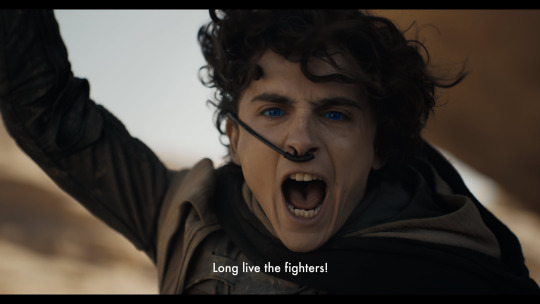
"We're Harkonnens... so that's how we'll survive. By being Harkonnens."

“You of all people should know there are no sides, Reverend Mother.”
Now, it’s fair to question the nihilistic bent of this (are we in the real world truly powerless to stop to this continuous catastrophe???), but the Angel of History and Dune use the stories they put forth as cautionary tales where that all-encompassing bleak endgame are meant to deconstruct our notions of progress and control. If we are powerless to shape history, how strong is the power we wield? And how good is the power we wield? As we strive for “paradise” and celebrate attaining it we often forget what happened as we got there, and we fail to see where we really are. If the reasoning for our actions doesn’t empower us, the effects of them in turn are even more debasing. The Baderoon poem that alludes to the Angel of History does so to examine this too. In its discussion of the end of apartheid and the ushering in of a democratic South Africa, “The Promised Land” weaves in the legacy of the jazz pianist Moses Molekelwa, who, despite influencing the poem’s speaker’s attitudes towards social progress (and appearing as an idol in that sense), is shown as getting off the hook in the eyes of history for strangling his wife to death. The triumph of his music is remembered while his wife’s murder is willfully forgotten, and the poem concludes that “our forgetting is also our home, which is why we will never leave the old country.” Baderoon warns of when the celebration of progress doesn’t factor in the ugly parts we still carry with us into the future, and her allusion to the Angel of History works to convey that danger. (Obviously the real anti-apartheid struggle of South Africa is very very different from the story of Dune, and I wouldn’t want to compare them to each other. Dune’s exploration of complicated progress instead speaks more towards the dangers of charismatic leaders and the co-opting of a cause). The only thing I want to highlight is just that Dune, Baderoon’s poem, and the Angel of History all hone in on the need to not lose sight of the now.



This is why the third act’s shift away from Paul works so well. The film doesn’t show people “forgetting” necessarily, but we do see them caught in the fervor without acknowledging what’s happening to them. Paul is an exception in that he sees it all: his arc sees him changing his perspective on the destiny laid ahead and taking control to ensure it happens on his terms. He doesn’t really turn evil, but since we’re denied of seeing past his new icy exterior as he looks ahead with his prescience, the film instead turns us back to the now, like the angel looking behind. We're with Chani now, the only (non-psychic) person who’s seeing this all. We already believe in Paul’s goodness. If we were to see what Paul sees and fully understand his reasoning, it would make it easy for us to downplay the costs. The story thus has us focus on the consequences of Paul’s path beginning to gather in real time, the Fremen being exploited as they are led into a coming bloodbath by their messiah.
And this is the sadness of it all, right? Things that were once honorable, like Jessica protecting Paul like she promised Leto and the legacy of Leto that Gurney hopes for Paul to carry with him, are twisted into foul and manipulative actions. Good intentions and real connections, like Paul’s empathy, his and Chani’s relationship, and his and Stilgar’s friendship, all give way to the storm.
The quickness of the third act’s events compounds this danger. The path Paul takes may be the best possible option after considering all the variables, but the story doesn’t revel too long in the glory of his successful leadership and strategy.

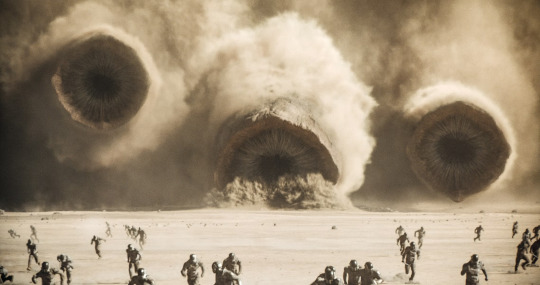
The awe-inspiring images speak not to just heroism but something volatile and intoxicating. It's not that the film oversimplifies the moral dilemmas at stake, but by letting the big battle, Gurney slaying Rabban, and Paul slaying the Baron happen all too easily, it removes the focus from only being the powerful exploits of Paul and the Fremen and adds emphasis on how they become like Harkonnens and how the Fremen become entrenched in Paul’s conquest. The Harkonnen bodies are burned like the Atreides were before them, and the Fremen Fedaykin ultimately fight carrying the Atreides banner instead of their own. They lose sight of this fact as they place all their faith in Paul, their cause and faith co-opted. It happens so fast and it can’t be stopped. We’re caught in the momentum of the storm raging, pushing us forward, and at the same time the film adjusts its focus to ensure that we don’t forget to recognize the consequences of Paul’s choices. This is what I find so compelling about this movie — we’re given a story that details the complexity of all things and also ultimately denies complicated factors and necessary evils of becoming excuses that wave the wreckage of progress away.

Hopefully this was enjoyable to read and wasn't pretentious or anything! Lemme know what you think about the movie!
#dune#long post#dune part two#dune movie#dune 2#dune part 2#dune 2024#paul atreides#kwisatz haderach#lisan al gaib#angelus novus#angel of history#determinism#frank herbert#denis villeneuve#gabeba baderoon#movies#movie review#movie discussion#movie analysis#film#film analysis#film discussion#media analysis#favorite movies#letterboxd#cinema#movie stills#movie photography#movie adaptation
6 notes
·
View notes
Text



“This is how one pictures the angel of history.
His face is turned toward the past. Where we perceive a chain of events, he sees one single catastrophe which keeps piling wreckage upon wreckage and hurls it in front of his feet.
The angel would like to stay, awaken the dead, and make whole what has been smashed.
But a storm is blowing from Paradise; it has got caught in his wings with such violence that the angel can no longer close them.
The storm irresistibly propels him into the future to which his back is turned, while the pile of debris before him grows skyward.
This storm is what we call progress.”
- Walter Benjamin
(“Angelus Novu” by Paul Klee, 1920.)
4 notes
·
View notes
Text

Paul Klee - "Gespenst eines Genies" (Ghost of a Genius) - 1922

Paul Klee . “Angelus Novus” (New Angel) - 1920

Paul Klee, “Bild aus dem Boudoir” (Picture from the boudoir)
(1922)
#klee#art#paul klee#picture from the boudoir#Bild aus dem Boudoir#angelus novus#Gespenst eines Genies#Ghost of a Genius
5 notes
·
View notes
Text
Angelus Novus
A Klee painting named Angelus Novus shows an angel looking as though he is about to move away from something he is fixedly contemplating. His eyes are staring, his mouth is open, his wings are spread. This is how one pictures the angel of history. His face is turned toward the past. Where we perceive a chain of events, he sees one single catastrophe which keeps piling wreckage upon wreckage and hurls it in front of his feet. The angel would like to stay, awaken the dead, and make whole what has been smashed. But a storm is blowing from Paradise; it has got caught in his wings with such violence that the angel can no longer close them. The storm irresistibly propels him into the future to which his back is turned, while the pile of debris before him grows skyward. This storm is what we call progress.
4 notes
·
View notes
Text
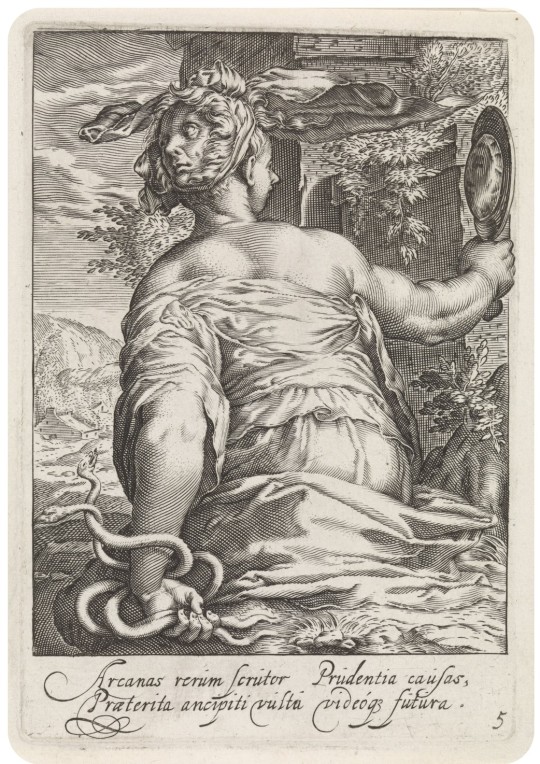
Kehren
1.
Kluge, juridische Kulturtechnik: Kehren, Queren, Wenden, Kippen, Drehen. Wenn das eine gründliche Kulturtechnik ist, weil sie auch in Gründungen vorkommt, dann ist das eine verschlungene Technik, auch weil sie verschlingt. In den Undwissenschaften ist hier und da von 'grundlegenden Transformationen', grundlegenden Änderungen die Rede. Man streitet darum, wem das Primat zukomme, solche Grundlegungen und Änderungen bewältigen zu können. Man diskutiert Veränderung auch als Bereitschaften und fragt, wer dazu wodurch bereit sei, wer nicht. Wen erwischt es auch ohne Bereitschaft, wen treffen Blitze, wenn sein Blitzen unvorbereitet? Wem, was und wodurch soll es jemandem oder einer Assoziation gelingen, etwas in der Geschichte, neues Wissen zum Beispiel, freizusetzen oder aber zu blockieren? Man versucht sogar, daraus Rezepte zu entwickeln und sogar eine Dogmatik, auch eine Bild- und Rechtswissenschaft, zum Beispiel eine Wissenschaft mit Bildern der schöpferischen Rechtssubjekte und einer Dogmatik ihrer Freiheitsrechte.
2.
Man schreibt teilweise, Grundlegung sei ein Paradox und versucht dann, das Paradox aufzulösen. Das heisst gleichzeitig, dass man der Kaskade von Austauschmanövern, denen das Dogma der großen Trennung aufsitzt, noch etwas draufsetzt. Autoren empfehlen zum Beispiel, solche grundlegenden Änderungskräfte nicht mehr bei Gott, sondern beim Menschen zu suchen, nicht mehr im Staat, sondern in der Gesellschaft, nicht mehr in Europa, sondern in Amerika, nicht mehr in den Konstitutionen, sondern den Institutionen, nicht mehr in der Politik, sondern in der Kunst.
Das berechtigte Interesse an Veränderung oder auch an der Generierung von neuem Wissen geht in seinen apologetischen Zügen (die man mit ihren Rückverweisen auf die Geschichte zurückliegender Erfolge auch wieder als Paradox markieren könnte, auch wenn das wenig erklärt) mit Gegenvorschlägen einher, die wie Gegenschläge kommen. Das ist eine vertrackte Situation. Ich glaube, dass man solche Situationen nur schlecht in Kategorien der Ablösung, der Erledigung, der Ausdifferenzierung und einer weiteren großen Trennung klären kann. Ich glaube aber gleichzeitig auch nicht, dass man heute noch einmal den Staat gegen die Gesellschaft oder aber die Politik gegen die Kunst und den Rest der Gesellschaft ausspielen kann. Können tut man immer alles, aber in jüngeren Texten zur Geschichte der Rechtsubjektivität zeigt sich eine arg kurzfristige Provokation, wenn einerseits die Offenheit der Zukunft beschworen wird und gleichzeitig versprochen wird, solche Institutionen identifizieren zu können, in denen die Zukunft sitzt. Der Gegensatz von gestern wird nicht der von morgen sein, unsere Übersetzungen werden zuerst uns übertölpeln.
2.
Kehren, das geht auch mit einer Bürste und gegen den Strich. Wenn Walter Benjamin in seinen Thesen zum Begriff der Geschichte auf ein verkehrtes Scharnier hinweist und dieses Scharnier den Angelus Novus nennt, dann ist das eine Idee, die schon einer Geschichte aufsitzt, die weder homogen noch leer ist. Er erfindet nichts, nichts aus dem Nichts. Er wendet etwas. Die Figur des Angelus Novus sitzt Figuren auf, ist aber nicht eine traditionelle Figur. Niemand beschreibt das wohl besser als Walter Benjamin selbst.
Ironie der Geschichte? Erst, als die Künstlerin R. H. Quaytman den Angelus Novus von Paul Klee nicht mehr als Bild im Sinne einer Ikone, eines Imago oder einer Pictura behandelt hat, sondern als ein geschichtetes, vages, verschlungenes und gewendetes Polobjekt, wurde entdeckt, dass das Bild von Paul Klee auf einer Graphik montiert wurde, die Martin Luther zeigt. Der Legende nach soll unter anderem die Welligkeit des Bildes, also seine 'vogueness' oder "vagueness" Quaytman stutzig gemacht haben und dazu gebracht haben, sich den Untergrund des Bildes genauer anzuschauen.
Nach fast 100 Jahren gibt es zu einem der meistkommentierten Bilder der Moderne noch eine Überraschung und eine neue Frage: Wußte das Benjamin? Wieso hat nix dazu gesagt? Ob das jetzt eine Ironie der Geschichte ist, oder nicht: Das empfiehlt eine Methode für Bild- und Rechtswissenschaft, die sich an Polobjekten orientiert, weil solche Objekte sowohl mit dem Bild als auch mit dem Bildgrund operieren. Sie operieren auf Schichten und durch Schichten, die vom römischen Recht getrennt werden. Sie operieren sowohl als imago, pictura oder scriptura, aber auch als tabula, d.h. mit den skalierbaren Operationsfeldern die man auch Tabelle oder Tablett(e), auch tab(u)linum oder tabulatorium nennen kann. Schon von da aus empfielt sich, auch eine Medienwissenschaft nicht als Wissenschaft großer Trennung zu betreiben, nicht Medien groß voneinander zu trennen, etwa um (sekundäre) Oralität gegen Schriftlichkeit so auszuspielen, wie man an anderer Stelle Kevin Kühnert gegen Steve Jobbs auspielt. Wenn andere Autoren Bild und Text mit "entscheidenden Gegensätzen" trennen, dann können sie das tun, aber sie sollten es nicht nur unter dem Dogma großer Trennung tun und sie sollten für alle Fälle mit Polobjekten rechnen.
3.
Aby Warburgs Begriff der Restitution sitzt quer zu einer Unterscheidung, die in manchen Wissenschaften eine Rolle bei Fragen nach den Veränderungen spielt. Dort unterscheiden Autoren mit unterschiedlichen Gewichtungen Konstitutionen von Institutionen. Teilweise wird daraus das Argument abgeleitet, dass Institutionen im Feld eines Primat gesellschaftller Praktiken lägen, sie seien für das 'Paradox der Gründung' dasjenige, was einer Gründung schon vorhanden sein muss, um etwas gründen zu können. Konstitution wird teilweise als Formalisierung, teilweise als Setzung und Akt gedacht. Als ein Begriff, der quer steht, ist der Begriff der Restiution nicht unbedingt ein Vermittler. Es ist aber auch kein Begriff, mit dem man etwas auslösen (oder aber herauslösen) könnte. Während die Unterscheidung zwischen Institution und Konstitution teilweise so gedeutet wird, sie liefe auf eine Fesselung oder aber Fesselbarkeit der Politik (einem ausdifferenzierten Element) und der Dynamisierung anderer ausdifferenzierter Elemente hinaus, entzieht sich ein Begriff der Restitution solcher Rollenverteilungen.
Die jüdische Kreuzestheologie operiert ohnehin anders als die katholische und erst recht anders als die protestantische Kreuzestheologie. Daneben gibt es auch unterschiedliche Techniken des Kreuzens. Ich mag zum Beispiel Kehren, Embleme oder aber die hochfetischistischen und schon perversen Tische von André Charles Boulle, aber auch Warburgs Staatstafeln, Klees Durchkreuzung und Stapelung und immer wieder Haufenbildung als Strukturprinzip. Das Dogma der großen Trennung oder die Theorien der Ausdifferenzierung haben meinens Erachtens nicht umsonst in Niklas Luhmann einen großen Autor gefunden, im Recht treiben nicht zufällig protestantische und sogar Herrenhuter Autoren das Geschichte der Kreuzungen auf immer neue Gipfel gelungener Trennung. Neue Texte zur Ablösung identifizieren, wo was falsch läuft und wo die Ausgänge liegen. Teilweise nörgeln die Autoren recht geschickt über die Nörgler, die angeblich zu viel vom Schlechten und zu Wenig vom Guten in der Welt sehen würden. Das Schöne daran ist, dass sie schon immer verloren waren, da kann man sich an der Bar treffen.
#prudentia bifrons#angelus novus#restitution#hendrick goltzius#institution#konstitution#Haufenbildung als strukturprinzip
14 notes
·
View notes
Text

Angelus Novus by Paul Klee
2 notes
·
View notes
Audio
Hatis Noit | Angelus Novus
3 notes
·
View notes
Text
1 note
·
View note
Text
"Hi ha un quadre de Klee que representa un àngel que està a punt d'allunyar-se d'alguna cosa que el deixa esbalaït. Té els ulls desmesuradament oberts, la boca badada i les ales esteses. Aquest és l'aspecte de l'àngel de la història. Gira la cara i mira cap al passat. Allà on nosaltres veiem una cadena de dades, ell hi veu una catàstrofe que amuntega als seus peus runa sobre runa. Ell voldria aturar-se, despertar els morts i recompondre allò que ha estat trossejat. Però des del paradís bufa un vent huracanat que se li enreda a les ales; és tant fort que l'àngel no pot tancar-les. Aquest huracà l'empeny irremissiblement cap al futur. Ell li gira l'esquena, mentre un munt de ruïnes creixen davant seu, fins a enfilar-se en el cel. D'aquest huracà, nosaltres en diem progrés."

0 notes
Photo

wip// been doing portrait semi-studies n reading on marxist critiques of the terror this december 🤠
#and the angelus novus is here.#maximilien robespierre#im on a train rn but i forgot to pack my tablet so i dont think this is getting finished OTL#robespierre#qqart#ive read a lot abt the reception of the frev as a figure of euro enlightenment but auditing an actual history course on its political#contingencies during the terror and anticolonialist recuperative critiques has tempered a lot of my most severe impressions of it LOL#frev
215 notes
·
View notes
Text
ready to call it. "crude drawing of an angel" is gonna be my song of the year.
#MISSSSS POLACHEKKKKKK#the whole album is good. but this one song in particular.#doesn't help that the first thing to come to mind when i saw the title was angelus novus
49 notes
·
View notes

